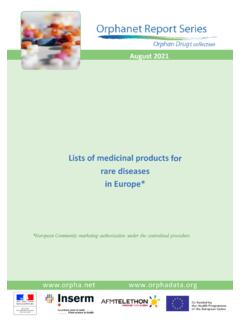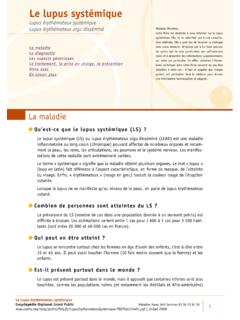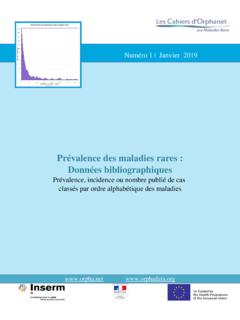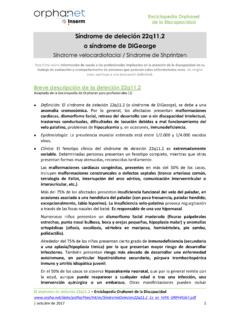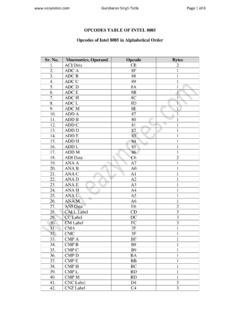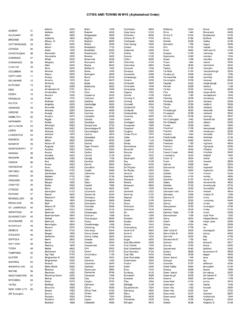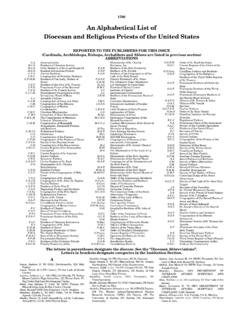Transcription of Prevalence of Rare Diseases by Alphabetical List
1 Number 1 | January 2022 Prevalence and incidence of rare Diseases : Bibliographic data Prevalence , incidence or number of published cases listed by Diseases (in Alphabetical order ) Without specification, published figures are worldwide. An asterisk * indicates European data. P indicates Prevalence data, I indicates incidence data and BP indicates birth Prevalence Orphanet Report Series - Prevalence of rare Diseases : Bibliographic data January 2022 - 2 Methodology Orphanet carries out a systematic survey of literature in order to estimate the Prevalence and incidence of rare Diseases .
2 This study aims to collect new data regarding point Prevalence , birth Prevalence and incidence, and to update already published data according to new scientific studies or other available data. This data is presented in the following reports published biannually: Prevalence , incidence or number of published cases listed by Diseases (in Alphabetical order ); Diseases listed by decreasing Prevalence , incidence or number of published cases; Data collection A number of different sources are used : Registries (RARECARE, EUROCAT, etc) ; National/international health institutes and agencies (Institut National de Veille Sanitaire (French Institute of Health Surveillance).)
3 American Center of Disease Control and Prevention, American National Cancer Institute, European Medicines Agency, World Health Organization etc) ; Medline is consulted using the following search algorithm : Disease names AND Epidemiology[MeSH:NoExp] OR Incidence[Title/abstract] OR Prevalence [Title/ abstract] OR Epidemiology[Title/abstract]; Medical texts, grey literature and reports from experts; Orphanet collaborating experts Data characteristics The data published in this document are worldwide estimations, or European estimations if a worldwide estimation is not available.
4 The published data is raw collected data or extrapolations of raw data at worldwide or European level when no genetic founder effect is suspected as a cause of a disease. If a range of national data is available, the average is calculated to estimate the worldwide or European Prevalence or a range of data sources is available, the most recent data source that meets a certain number of quality criteria is favoured (registries, meta-analyses, population-based studies, large cohorts studies).
5 For congenital Diseases , the Prevalence is estimated, so that: Prevalence = birth Prevalence x (patient life expectancy/general population life expectancy). When only incidence data is documented, the Prevalence is estimated when possible, so that : Prevalence = incidence x disease mean duration. When neither Prevalence nor incidence data is available, which is the case for very rare Diseases , the number of cases or families documented in the medical literature is provided. Limitations of the study The Prevalence and incidence data presented in this report are only estimations and cannot be considered to be absolutely correct.
6 The average values presented in this report do not take into account the heterogeneous nature of the methodologies employed by the studies considered in the literature survey. The validity and exactitude of raw data sources is taken for granted and have not been verified. Thus, confusion between terms such as incidence and Prevalence and/or birth Prevalence is possible due to the interchangeable use of these terms in certain sources. It is possible that Prevalence is overestimated in some cases as epidemiological studies are generally based on hospital data in regions with higher Prevalence .
7 Data presentation Without specification, published figures are worldwide. An asterisk * indicates European data. P indicates Prevalence data I indicates incidence data. BP indicates birth Prevalence Please note that this is just a selection of Orphanet's rare disease epidemiological data. Currently 6053 rare Diseases are annotated with Prevalence or incidence information in the Orphanet database. To access the complete data sets visit Orphadata ( ). Without specification, published figures are worldwide. An asterisk * indicates European data.
8 P indicates Prevalence data, I indicates incidence data and BP indicates birth Prevalence Orphanet Report Series - Prevalence of rare Diseases : Bibliographic data January 2022 - 3 Prevalence , incidence or number of published cases listed by Diseases (in Alphabetical order ) ORPHACode Disease or Group of Diseases Estimated Prevalence /incidence (/100,000) Number of published cases or families 300305 microduplication syndrome 1 Family 444002 microdeletion syndrome 5 Cases 313884 microdeletion syndrome 11 Cases 94063 12q14 microdeletion syndrome 22 Cases 289513 microdeletion syndrome 6 Cases 412035 microdeletion syndrome 3 Cases 261120 microdeletion syndrome 3 Cases 261229 microduplication syndrome 7 Cases 264200 14q22q23 microdeletion syndrome 5 Cases 401935 microdeletion syndrome 3 Cases 488280 14q32 duplication syndrome 33
9 Cases 314585 15q overgrowth syndrome 12 Cases 261183 microdeletion syndrome 200 Cases 238446 15q11q13 microduplication syndrome 30 Cases 199318 microdeletion syndrome 246 Cases 261190 15q14 microdeletion syndrome 9 Cases 94065 15q24 microdeletion syndrome 30 Cases 261211 microdeletion syndrome 8 Cases 261204 microduplication syndrome 7 Cases 485405 triplication syndrome 3 Cases 261236 microdeletion syndrome BP 261243 microduplication syndrome 162 Cases 500055 microdeletion syndrome 6 Cases 96078 microduplication syndrome 27 Cases ORPHACode Disease or Group of Diseases Estimated Prevalence /incidence (/100,000)
10 Number of published cases or families 352629 microdeletion syndrome 42 Cases 261250 microdeletion syndrome 27 Cases 217385 microduplication syndrome 50 Cases 97685 17q11 microdeletion syndrome 170 Cases 139474 microduplication syndrome 7 Cases 261265 17q12 microdeletion syndrome 103 Cases 261272 17q12 microduplication syndrome 118 Cases 363958 microdeletion syndrome P* 261279 microdeletion syndrome 7 Cases 529962 microdeletion syndrome 19 Cases 254346 microdeletion syndrome 6 Cases 357001 microdeletion syndrome 7 Cases 447980 microduplication syndrome 6 Cases 217346 microdeletion syndrome 12 Cases 293948 microdeletion syndrome 9 Cases 401986 1p31p32 microdeletion syndrome 5 Cases 456298 microdeletion syndrome 2 Cases 250994 microduplication syndrome 46 Cases 238769 1q44 microdeletion syndrome 100 Cases 79154 2-aminoadipic 2-oxoadipic aciduria 20 Cases 79157 2-methylbutyryl-CoA dehydrogenase deficiency 30 Cases 261295 microdeletion
